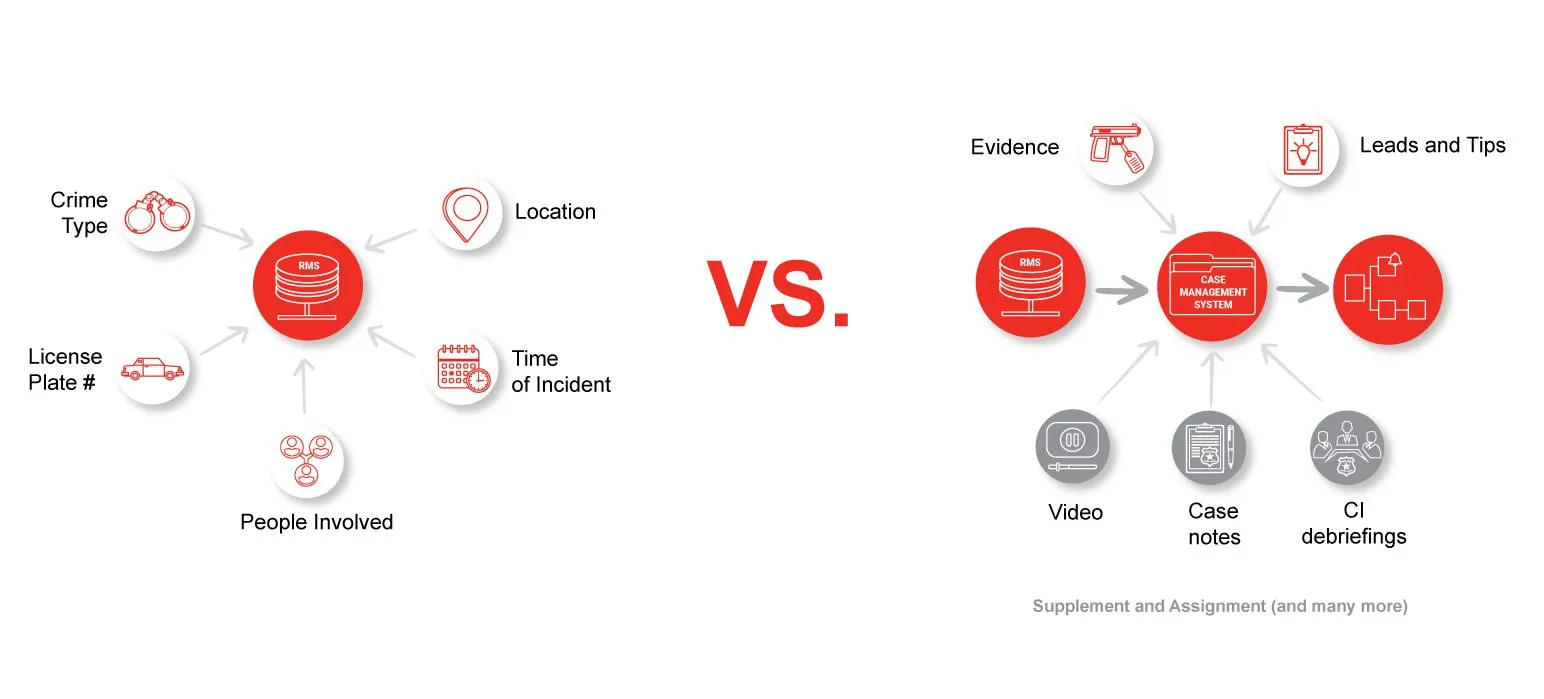Currently, most record management systems (RMS) are designed primarily for reporting incidents at the patrol level, and they lack the analytical capabilities and task management for law enforcement investigations that have greater complexity. Yet, most law enforcement departments are still primarily leveraging RMS for police operations, and ultimately losing key functionality when it comes to their investigations.
In this blog, we’ll discuss some of the key differences between RMS and case management software, the argument for separating investigative data from RMS data, and how a case management platform like CaseBuilder® can help investigators improve their day-to-day operational effectiveness.
Differences Between RMS and Case Management Software
Police record management systems (RMS) are generally designed to record criminal incidents in compliant reports. Many providers do this well, but law enforcement’s job goes beyond just filing reports. Cross-departmental investigative work and the management and organization of workflow activities are also critical parts of an investigator’s job, and these are some of the types of tasks that RMS applications are not designed to handle.
Case management software, on the other hand, provides the tools that law enforcement needs to run a modern investigative unit, including incident-level reporting, investigative management, necessary integrations with other systems, and so on. Ultimately, we believe that a modern-day law enforcement department needs both an RMS application and case management software to be successful.

The Argument for Separating Investigative Data from RMS Data
An RMS is where law enforcement stores a massive amount of information (including incidents, arrests, citations, and warrants) and, as such, can be quite unwieldy for managing complex investigations and supplemental information.
While RMS applications succeed in capturing summary data to submit to a National Incident-Based Reporting System (NIBRS), they do a poor job of managing and organizing workflow activities that become so critical when managing a more complex case. This is precisely where case management software becomes such an indispensable tool.
With that said, let’s move on to a discussion about the different functionalities of case management platforms and how they can help law enforcement agencies improve operational effectiveness in several key areas.
Data Privacy
Inevitably during an investigation, new information will be discovered and gathered and it’s beneficial to separate that data from all the other data in an RMS. It’s also important to firewall that data and allocate privacy permissions on a need-to-know basis. CaseBuilder offers four levels of security clearance: Unclassified, Restricted, Classified, and Sensitive. We isolate the investigative data and provide strict controls, including login access by user permissions as well as an audit trail. Furthermore, CaseBuilder is a 28-CFR compliant platform, adhering to all guidelines around the protection of constitutional rights and reasonable expectations of privacy.
Compliance
CaseBuilder’s integration strategy adheres to the industry’s most stringent requirements, leveraging standards and best practices set forth by the International Association of Chiefs of Police (IACP), the International Justice Information Systems (IJIS), the FBI’s N-DEx using Information Exchange Package Documentation (IEPD), and the National Information Exchange Model (NIEM). An open architecture and standards approach provides security, stability, and a repeatable solution for all CaseBuilder users.
Ability to Organize and Manage Massive Amounts of Data
Massive amounts of data are leveraged throughout the course of an investigation, from 9-1-1 audio call data, radio recordings, surveillance or body cam video, CAD recordings, and personnel records, to a variety of images and documents. With CaseBuilder you can organize and manage all these data sources within a single case folder. Assigning follow-up actions for different department members and securely providing a complete case file to prosecutors are essential provided features. Furthermore, CaseBuilder’s advanced analytic capabilities enable investigators to identify trends and patterns in mountains of evidence and then turn these insights into action items, solving complex cases quickly and with greater accuracy.
Ease of Integration
SoundThinking™’s approach to the integration of CaseBuilder with RMS applications is based on industry standards and principles. SoundThinking recognizes that the following key integration points are typically deemed necessary:
- Consume – Incident and Crime Report data that necessitates a formal investigation.
- Query – Provides the ability to query against existing content, data, entities and historical records from the case management system to the records management platform.
- RMS Case Updates – Optional support for case closure updates to the legacy records management system to update crime incidents and the clearance of offenses.
Better Policing with Technology
Today, agencies nationally are battling a violent uptick in crime with fewer resources than ever before. Efficiency is more important than ever before, and as technology evolves, law enforcement agencies need to be able to evolve accordingly too to maximize operational effectiveness.
Documenting a complex case and working in tandem with a variety of collaborative stakeholders is no easy feat. CrimeTracer is a valuable tool that eliminates the redundant manual entry of information and empowers all investigative units to do their jobs more accurately, efficiently, and successfully.





